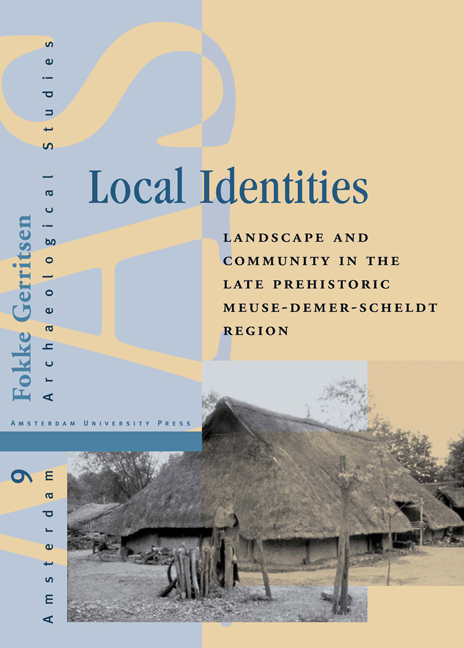Book contents
- Frontmatter
- Contents
- Acknowledgment
- 1 Introduction
- 2 Archaeology in a Sandy ‘Essen’ Landscape
- 3 The House and its Inhabitants
- 4 Local Communities and the Organisation of the Landscape
- 5 Micro-Regional and Regional Patterns of Habitation, Demography and land use
- 6 Landscape, Identity and Community in the First Millennium BC
- Abbreviations
- References
- Appendix 1 Meuse-Demer-Scheldt Region. Distribution of Urnfields
- Appendix 2 Catalogus of Urnfields
- Index of Geographical Names
- Frontmatter
- Contents
- Acknowledgment
- 1 Introduction
- 2 Archaeology in a Sandy ‘Essen’ Landscape
- 3 The House and its Inhabitants
- 4 Local Communities and the Organisation of the Landscape
- 5 Micro-Regional and Regional Patterns of Habitation, Demography and land use
- 6 Landscape, Identity and Community in the First Millennium BC
- Abbreviations
- References
- Appendix 1 Meuse-Demer-Scheldt Region. Distribution of Urnfields
- Appendix 2 Catalogus of Urnfields
- Index of Geographical Names
Summary
GENERAL THEME AND AIMS OF RESEARCH
In this study I will draw on a range of archaeological materials to present a history of the communities inhabiting the Meuse-Demer-Scheldt (MDS) region between the beginning of the Late Bronze Age and the beginning of the Roman period.The aim is to elucidate some of the major social and cultural transformations that occurred during that period, covering roughly the first millennium BC.While a number of different histories could be written about the region and period, this one takes the form that it does because of the central theme that lies at its core: the reciprocal and dynamic relationships between human groups and the landscape.
This is a broad and vague description for a research theme; one that without further elucidation can conjure up quite different things, from ecologically-determined ‘people-land’ relationships to conceptualised landscapes and mythical geographies. It clearly needs a more precise definition; for the time being, however, I will retain this broad description and gradually clarify it in the course of this introduction. Moreover, as will become clear, the inclusiveness suggested by the description is an essential feature of the perspective that I advocate.
As a first exposition of the theme that I refer to as ‘reciprocal and dynamic relationships between human groups and the landscape’, let me briefly present a historical situation which contains in condensed form many of the elements that lie at the core of the subject of this study. In his book Bad land. An American romance the travel writer and novelist Jonathan Raban describes the history of the homesteaders on the prairie of Montana in the United States. Attracted by the prospect of a tract of free land, people from Europe and the American east coast settled down on the prairie in the early years of the twentieth century. They found themselves in a vast open space, totally devoid of geographical features that could orient them.There was nothing there with which they could in some way identify, nothing to remind them of their native villages and towns. It was a landscape without history, or more precisely, without a history that they knew how to read.
- Type
- Chapter
- Information
- Local IdentitiesLandscape and Community in the Late Prehistoric Meuse-Demer-Scheldt Region, pp. 1 - 16Publisher: Amsterdam University PressPrint publication year: 2003



